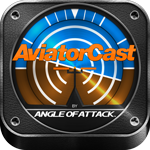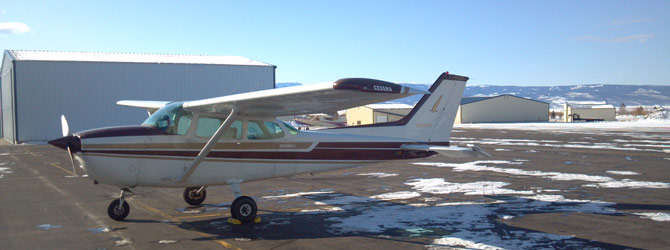
While the Vatsim P1 is much less rigorous than this, the P2 starts to cover much of what I had to do in my private pilot practical exam. With the exception of the “seat of the pants” feeling, all of the maneuvers can be practiced on Flightsim quite easily. One of the things we concentrate on here at Angle of Attack is becoming great aviators. I believe that the sim helped me (literally and figuratively) fly through my private pilot pracitcal exam. I hope you’ll indulge me as I take you through what the big day was like.
Arriving at the FBO
My Practical was scheduled for Monday morning at 9:00am; my designated pilot examiner (DPE) Tom was scheduled to arrive in his Warrior from South Valley Regional (U42) right at 9, so I got there around 8:30 assuming that the FBO would be closed but wanting to be ready to greet him when he arrived. The local manager Lara, however, is incredible and had shown up to open the hangar at 8:00 that morning just because she knew I had my practical. This, combined with weather preventing quick clearances out of the SLC area allowed me about 45 minutes to go through the 172XP (N1324V) and pull out the necessary documentation for the oral section of the exam.
I also did a preflight to make sure everything seemed in order for the flight later that morning; it was a couple of quarts low so I made sure she was topped off. Then I went into the training room and organized all of my material in the order I thought we’d go through (Logbooks, ID and medical, required documents for the aircraft, cross country planning and charts, and then my FAR/AIM and PTS books)
When Tom arrived, Lara and I pushed the two FBO aircraft out of the hangar and parked them on the ramp so that we could put his Warrior in the hangar to keep it warm (temps were just below 0 F when he touched down). Once he was situated, we started with the easy stuff – review of logbooks, entering my ID and Medical info into IACRA, and e-signing the various intro documents (like pilot’s bill of rights for example); then we got down to business.
The Oral
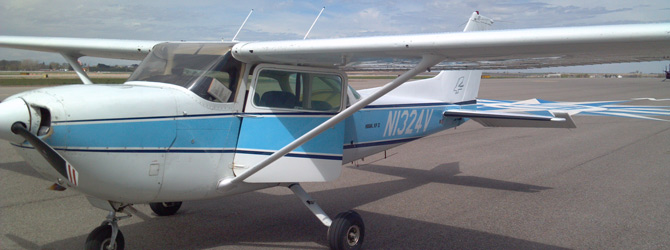
Tom started by asking me what documentation I needed to fly, and followed that up with currency. We moved on to required equipment, inspections, and maintenance logbook entries. He had me show him each and explain what was necessary and show that 24V was up to date as needed. I didn’t have a list of all the AD’s, but did have the mechanics signature saying that all AD’s were up to date – shich proved sufficient for the purpose of the exam.
Cross-Country review
Then it was time to review the cross country (KIDA V21 PIH U01 vectors (avoid the lake using pilotage) V269 BYI V4 KBOI); we spent some time going over my flight plan and the log sheet I had filled out – he asked me a few cursory questions about how I had calculated this fuel burn or that magnetic course. He also had me show him how I had arrived at the weight and balance calculation – without having to calc it again (I basically needed to show that I could use the graphs appropriately and understood the implications).
I had planned KIDA – KBOI on victor airways, with the exception of a short haul from the PIH VOR to American Falls and then cross only the tip of the American Falls reservoir (where it’s only about 2NM wide), I mentioned that I had done this to ensure power off glide to the shore at all times, he indicated that he would have asked that question and was glad I answered it well.
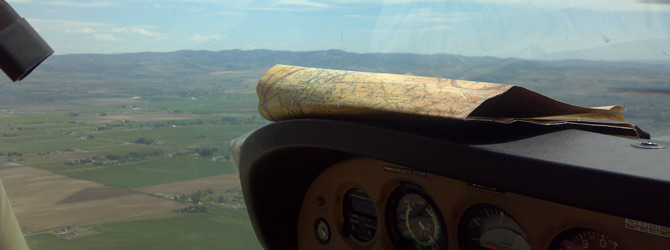
Charts & Symbols
He then pulled out the SLC Sectional and presented several scenarios. Starting in Idaho Falls (KIDA) he covered SFVR clearance (we actually simulated the radio communications with him taking the part of the KIDA Tower); he tripped me up a bit when he pointed to a spot on the map out of the Delta airspace and I forgot to look to see that it was still in Echo to the surface, but I quickly recovered and explained what the dashed magenta line was and why it was there.
We ended up talking about most airspaces and I had to give him VFR minimums, which I was able to do rather easily. On the way back he had me flying through several MOA’s and Restricted areas and allowed me to look at the legend to determine operating hours and controlling agencies – he also had me do a low pass over Mountain Home AFB and asked if it was legal (key: it’s military, not likely in the A/FD so look at it on the Sectional key to see operating hours and determine if it’s open; and — it’s my airspace unless they tell me it’s not so if it’s closed I can do anything that’s legal in the prevailing airspace; in this case G so go buzz the runway and look at the F16’s dude — that was my DPE talking, who used to be an approach controller with ZLC (real world) as well as an FAA Safety inspector). I did fumble a bit when he asked me what VFR ceiling/visibility requirements were for takeoff from a controlled airport. He said most folks skip over that, should have been an easy one.
He asked me about emergency procedures a little, and asked me about clearance/equipment requirements for Delta, Charlie and Bravo airspaces.
Weather – the One We All Dread
Then he had me pull out the weather charts – I read the METAR for KIDA, by the time I go to the comments he indicated I should move on; he then had me read the KBOI TAF and after the first “FM” line he motioned for me to stop. We looked at some prog charts I had printed from DUATS covering the weather on the day I had used to plan my cross country (it was two days prior, he had told me I could plan it on any day, just to make sure I brought in the weather info for the day I had planned). He had me talk about each kind of front (by pointing to it on the depiction and asking what it was, and what weather I could expect in various areas around the front).
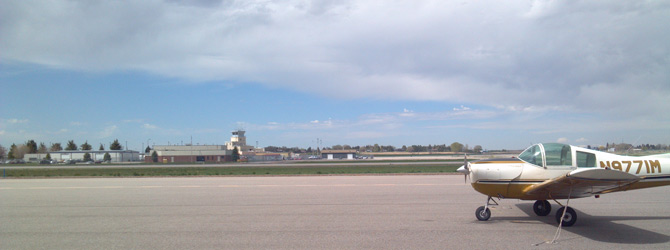
Wrap-Up and Checkride Prep
After that he looked at my written exam report, I had missed 3 questions with 3 different knowledge codes, so he looked them up and asked me a few questions covering those topics. When he was satisfied that I was knowledgeable in those areas he started to explain what the checkride would like like.
Tom let me know that after I took him through the preflight, I would be taking off using the short-field technique, then I would take him to whatever practice area I was comfortable with, preferably somewhere to the north or west. He then explained pretty much exactly what maneuvers and in what order we’d be doing it them (I’ll detail those below), including hood time and flight back to the airport for the final landing and takeoff practices.
He mentioned that when I demonstrated emergency approach to land over the practice area if I ended up slipping to the landing before go-around that would count, if not we would be doing a practice slip to land at the airport. (i.e. hint hint – please slip to a landing for the emergency practice)
The Checkride
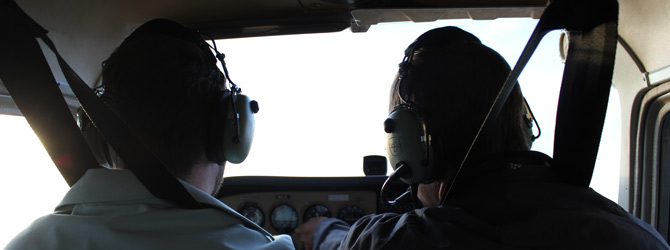
Once at the plane I walked him through my preflight; I pulled out the checklist and he asked me immediately if I ever saw airline pilots with a checklist – “it’s a checklist, not a to-do list” he told me. So I put it away and walked around the plane, explaining to him what I was looking for. He pointed out some really interesting things that I didn’t know – nothing that made me feel as though I had failed, just additional knowledge from an experienced pilot.
Everything checked out, so we crawled into the cockpit. I let him know that I would be talking out loud a lot, and there would be some things that I assumed he would know that I would tell him anyway. I also told him that I was pretty nervous. He took me through the required DPE intro – let me know that I was pilot in command, that he would take the controls 3 times (1 – so that I could put on my foggles, 2 – so that he could put the plane in an unusual attitude, and 3 – so that I could take off my foggles) and that if he took it a 4th time or not for the reasons listed that the checkride would likely be over. He told me that either of us could stop the checkride at any time, and that you couldn’t fail the whole checkride – just sections, so failing a portion didn’t mean we needed to terminate unless I just couldn’t get it back together again.
Because we had left 24V outside, it had a HARD time cranking – he and I both had troubles getting her to turn over; he showed me a few tricks, but we just couldn’t get it going. Eventually we killed the battery so we stepped back inside and called for a cart — as we left I could see the pool of avgas under the plane and pointed it out, he said that it was probably good we were going to wait a few.
He mentioned that he was confident based on my oral that I would be safe, so if 24V wouldn’t start I could fly his plane for the checkride, he’d just have me pay for gas and give me a quick tutorial on the way out. I had flown a PA-28 Arrow to practice in the weekend before, so I was comfy with a low wing and the basic Piper setup so it seemed like a good alternative to me.
Basic and Ground Reference Maneuvers, Emergencies
The mechanic got it started for us, so Tom slid into the right seat and held the brakes while I traded with the mechanic and we were ready to go. I got my ATIS and called for clearance. I talked him through my run-up and the checklist for a short-field takeoff, then executed, making sure to peg it at the checklist indicated airspeed.
At about 150ft AGL Tom told me that I had cleared the obstacle and could ascend normally. I waited until I had gotten to best climb, then started cleaning up (raising flaps, pulling the prop back) and once we were cleared I headed to the Northwest Practice area (an area over a small cinder butte and lots of farm fields about 8 miles NW of KIDA).
He told me to climb to 7500, I made sure that once I hit it I stayed there while we were headed to the practice area just in case. We jabbered a little on the way out, and shortly after I called clear of Delta and crossed the landmark we all used as the beginning of the practice area he asked me to execute some steep turns.
I told him that I would like to do clearing turns first, which he indicated was fine. Once clear, I picked a heading (a peak to the west that happened to be nicely lined up with the roads); I’ll brag here a bit; ¾ of the way through the first turn he said “your altimeter is broken; it hasn’t moved at all.”
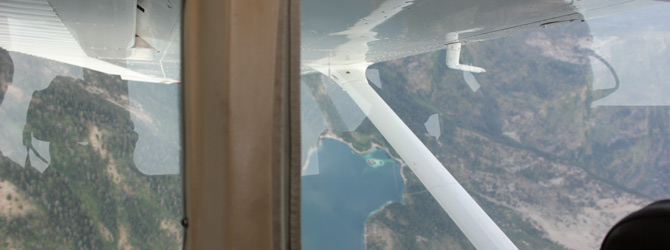
Following the steep turns he asked me to slow to 65 knots and add full flaps when safe, holding my altitude. Once I had flaps fully extended he had me do a couple of turns, then asked me to enter a stall. At the buffet (a much softer buffet than I had practiced getting to) he indicated that I should recover; I forgot to push the power and went immediately to the yoke and pulled my flaps to 20. I was able to recover but he asked me what I missed – when I told him he asked me to try again. I did, this time I just dipped my nose below the horizon on the buffet, pushed the throttle in, then started cleaning up. He was much happier.
Next we did a power on stall – this one went much more smoothly. Almost immediately after I had established straight and level flight he pulled my throttle and told me that I had an engine failure; I pitched for best glide – he then changed the scenario and said it was a fire. I pitched to 105 kias and we descended quickly for a while, at which point he told me the fire was out, go land. I picked a field and started my approach.
I may have landed it, but it was looking like I’d be a bit long so he asked me to go around and said that we would probably try it again later.
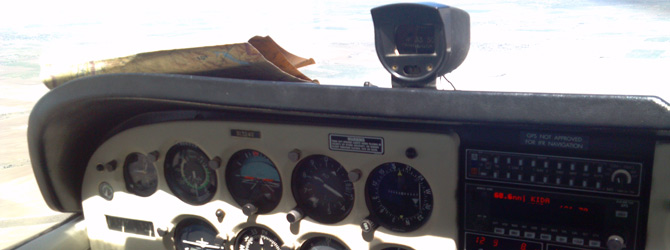
He had me climb to 1000 AGL and asked me to find an east-west road since the wind was out of the north and show him some S-turns – I kept it within about +/– 50 of my altitude; those went well so I did a turn around a point (I picked an irrigation pivot and after one left hand turn he said that was good enough).
At that point he pulled my throttle again and told me it was an engine failure, no time to restart just land. I picked a field (better field this time) and descended full flaps at best glide toward it. At about 500 AGL I was too high to make it so I slipped, passed over the road in front of the field at about the right height for a good soft field so he had me go around, and indicated that that would be good for both emergency landing and slip to landing. Have to admit, even in all the practice with my CFI I hadn’t gotten that low over a field. It was uphill on the backside so I paid a LOT of attention to best climb over distance and got her up and safe.
Unusual Attitudes, Basic Instrument Knowledge
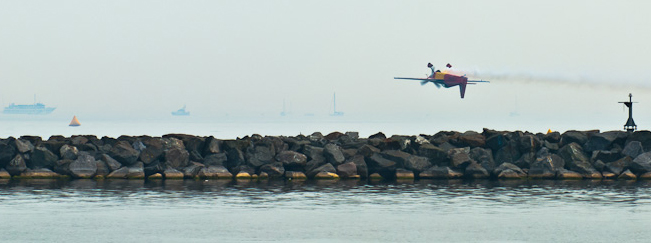
Once we were high enough to safely transfer he asked for the controls – we engaged in positive transfer and then he asked me to put on my foggles. He had me turn to headings – mostly cardinal, stick it at 70kts, and we did several variations of ascents and descents. He did get after me a few times about turning too steeply (not standard rate on the turn/slip indicator). He then had me put my head in my lap and after a while told me to fix the unusual attitude – I was in a very steep climb with my left wing quite low… I corrected immediately so he told me to tune to the IDA VOR and fly straight toward it.
I tuned, and he asked me if I was sure that was the VOR; I pushed Nav 2, listened for the Morse code and showed him on my sectional (which I had already folded to allow me to quickly reference) that we were tuned appropriately. I then navigated over the VOR. Entering Delta Tom called the tower and asked clearance to overfly the VOR and then enter the pattern for Stop and Gos. Admittedly it wasn’t my best VOR track, I’m sure if I could see it on a map I was actually doing a bunch of lazy S-Turns over the radial rather than pinning it, but we got there.
Shoft/Soft Landings and Takeoffs
Once over the VOR he had me remove the foggles and we were set up on a high left downwind for 20; we had a regional (CRJ) on downwind about 5 miles outside our pattern and were asked to do a short approach; Tom told me that we were practicing a scenario: the runway was covered in fresh snow, I needed to do a soft field landing and he would tell me when the snow pack was safe enough to put the nosewheel down. Once I put the main gear down I kept the nose up until he told me it was safe.
I stopped, then we took off shortfield. Once in ground effect a slight cross wind hit me and as I corrected my charts and A/FD came tumbling into my lap – he laughed and said that it saved him from having to simulate a distraction. At about 500 AGL he looked out his window and said “Huh, the runway’s out my window” (The distraction and the crosswind had gotten me a bit out of allignment). I told him I just wanted to give him a good view of the pretty runway. He laughed, and asked me if I had seen Pearl Harbor recently, I told him I handn’t. He said there was a line that applied: “That’s bull; it’s good bull, but it’s bull” (his language was a bit more colorful).
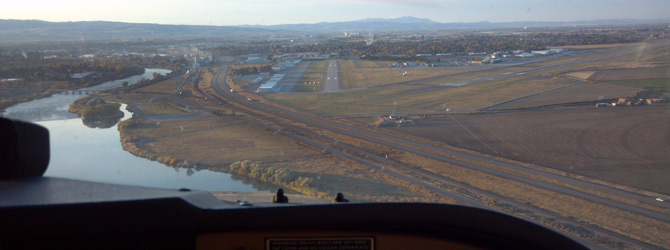
Getting My Ticket Punched
He asked me to call for the option, which we were given. I paid special attention to keep my pattern precise and my altitude spot on. He then asked me to do a short field approach over a 50 foot obstacle. I came in a bit low, so he asked me to try again – this time we landed full stop on 17 and on the taxi back to the FBO he looked at me and said “I think you’ll make a safe private pilot.”
My sim time time definitely helped me; as I’ve said in earlier posts – radios are second nature thanks to my time online, and the mechanics of most procedures come naturally – that leaves me with learning seat of the pants or the “feel” of flying – which is easier to learn when the rest of it is already intuitive.
I have to say that aside from a few key life moments (my wedding, the births of my 3 kids), getting my ticket punched to fly the skies based purely on my own decision making and go where I chose to go was one of the best feelings I’ve had. It’s been a great journey – and I look forward to getting Cloud Certified next.
This article was posted in Aviation, Basics, Become a Pilot, Blog, Flight Simulator, Real World, Uncategorized
Please note: We reserve the right to delete comments that are snarky, offensive, or off-topic. If in doubt, read the Comments Policy.

